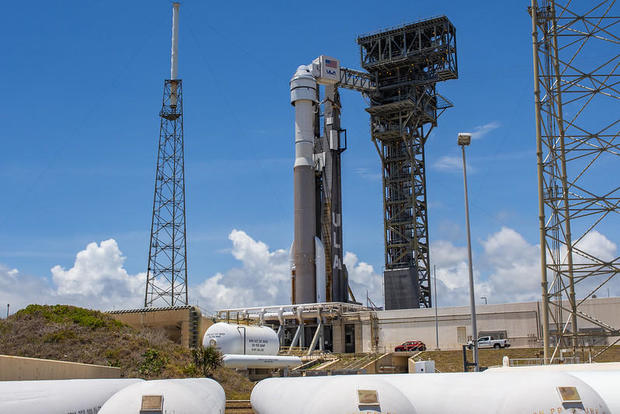
Long-delayed Boeing Starliner ready for first piloted flight to the International Space Station
Years behind schedule and more than a billion dollars over budget, Boeing’s Starliner capsule is finally poised for its first piloted launch Monday, a critical test flight carrying two veteran astronauts to the International Space Station and in so doing, demonstrate an alternative to SpaceX’s already operational Crew Dragon.
While SpaceX has launched 50 astronauts, cosmonauts and civilians into orbit in 13 piloted Crew Dragon flights since May 2020, Boeing has been bedeviled by multiple technical problems that required extensive re-work — and an additional unpiloted test flight — to resolve.
But mission managers say all the known issues have been corrected, multiple other upgrades and improvements have been implemented and the spacecraft has been thoroughly tested to verify it is finally ready to safely carry astronauts to and from the space station.
United Launch Alliance
No one is more eager for launch than the Starliner’s crew, both active-duty NASA astronauts.
unexpected software and communications glitches prevented a planned rendezvous with the space station. Boeing corrected those problems and opted to carry out a second uncrewed test flight, at its own expense.
But during the second countdown, engineers ran into problems with stuck propulsion system valves in the Starliner’s service module. Engineers eventually traced the problem to moisture intrusion and corrosion, triggering another lengthy delay.
The second Starliner test flight in May 2022 was a success, docking at the space station as planned and returning to Earth with a pinpoint landing. But in the wake of the flight, engineers discovered fresh problems: trouble with parachute harness connectors and concern about protective tape wrapped around wiring that could catch fire in a short circuit.
Work to correct those issues pushed the first crewed flight to this year. When all was said and done, Boeing spent more than $1 billion of its own money to pay for the additional test flight and corrective actions.
A critical mission for Boeing
The CFT launching comes at a critical time for Boeing given the aftermath of two highly publicized 737 Max crashes in 2018 and 2019 and more recently, the blowout of a cabin door “plug” during an Alaska Airlines flight that has raised fresh questions about the company’s safety culture.
For his part, Wilmore said he didn’t view the Starliner launch in the context of Boeing’s trouble with its airplanes.
“I don’t think it has necessarily anything to do with Boeing and a flight going off,” he said. “They’re all vitally important. This is human spaceflight. That adage you’ve heard since Apollo 13, failure is not an option? That has nothing specifically to do with Boeing or this program. That’s all the things that we do in human spaceflight.
“So, this one is no more or less important than anything else we’re doing,” he said. “It just happens to be the most important one we’re doing right now.”
Williams acknowledged the Starliner’s rocky road to launch. “I’m not going to say it’s been easy. It’s a little bit of (an) emotional roller coaster.”
But, she added, “We knew we would get here eventually. It’s a solid spacecraft. I don’t think I would really want to be in any other place right now.”
More
More
Source: cbsnews.com